Explore Punakha - Bhutan Travel, Asia
Nestled in the lush valleys of the Himalayas, Punakha is a destination that captivates every traveler with its breathtaking beauty and deep-rooted cultural heritage. Once the capital of Bhutan, this serene town offers the perfect escape for those seeking both tranquility and adventure. The landscape is dominated by green terraced rice fields, winding rivers, and the stunning Punakha Dzong—a fortress that stands as a symbol of Bhutanese architecture and history. Whether you’re a history enthusiast, a nature lover, or a spiritual seeker, Punakha is a treasure trove of experiences waiting to be discovered.
Population: Approximately 28,700 in 2017.
Economy: Punakha's economy is primarily based on agriculture, with rice and livestock farming being key contributors. Tourism also plays a growing role, thanks to its historical landmarks and natural beauty.
Landmarks: Famous for the Punakha Dzong, Chimi Lhakhang (or Temple of Fertility), and the Punakha Suspension Bridge.
Bhutan

Overview of Punakha
History & Cultural Influence
Punakha has a significant place in Bhutanese history because it was the country's capital for over 300 years, from the 17th to the early twentieth century, and it is still a spiritual and cultural hub today. The Punakha Dzong, also known as the "Palace of Great Happiness," is a famous landmark in Bhutan and a symbol of Tibetan Buddhism's influence on daily life in Punakha. Traditional beliefs and customs are still practiced widely, from local festivals to rituals performed at the temples. One could say that exploring Punakha is like stepping back in time, where the town’s culture is deeply intertwined with its history.
Interaction with the Locals
Punakha has a modest population, with most residents living in small villages scattered across the valley. The majority of the citizens are of Bhutanese ethnicity and follow Tibetan Buddhism, which heavily influences their daily lives and cultural practices. Punakha’s people are known for their warm hospitality, close-knit communities, and strong ties to agricultural traditions. Despite modernization in some areas, the residents maintain a peaceful, simple lifestyle deeply connected to nature and spirituality.

Punakha Suspension Bridge - © Faris Mohammed
Top Attractions in Punakha
Punakha boasts some of the most iconic landmarks in Bhutan, each offering a unique window into the country’s history, spirituality, and natural beauty. Whether you are visiting for cultural exploration or scenic adventures, these top attractions are unmissable.
Punakha Dzong
The Punakha Dzong is the crown jewel of Punakha and a must-visit for every traveler. This great fortress, constructed in the 17th century, is situated at the junction of the Pho Chhu and Mo Chhu rivers. It is revered as a spiritual and administrative center and showcases exquisite Bhutanese architecture. The dzong is also home to important relics and the sacred remains of Zhabdrung Ngawang Namgyel, Bhutan's unifier.
Chimi Lhakhang (Temple of Fertility)
Known for its unique traditions, Chimi Lhakhang is a popular pilgrimage site. The temple was established to venerate Drukpa Kunley, a Buddhist saint also known as the "Divine Madman." Couples frequently visit Chimi Lhakhang to pray for fertility, and the temple is famous for its unique artwork of phalluses, which represent fertility and protection from evil spirits.
Punakha Suspension Bridge
Adventure lovers will enjoy the Punakha Suspension Bridge, one of the longest suspension bridges in Bhutan. Spanning over 160 meters, this bridge offers breathtaking views of the valley below and the rushing Mo Chhu River. It’s also a great spot for photography, capturing both the scenic landscape and the traditional prayer flags fluttering in the wind.
Khamsum Yulley Namgyal Chorten
This beautiful stupa, perched on a hilltop overlooking the Punakha Valley, is a masterpiece of Bhutanese architecture. The Khamsum Yulley Namgyal Chorten was built to promote peace and harmony, and its intricate details make it a must-see for those interested in Bhutanese art and spiritual design. A short hike through rice fields leads you to this stunning monument, offering panoramic views of the Punakha countryside.
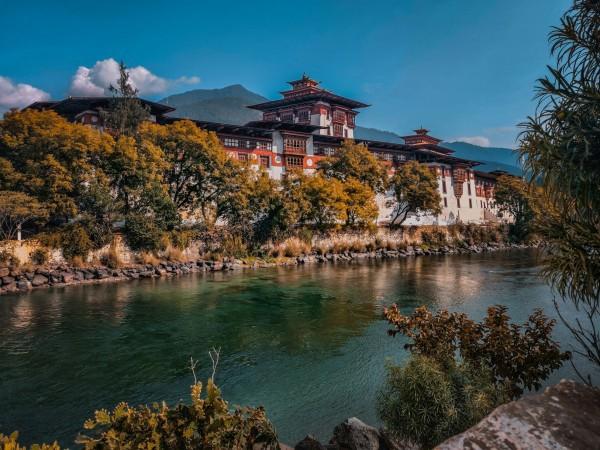
Punakha Dzong - © Arghya Mondal
Must-Try Dishes in Punakha
Bhutanese cuisine is known for its bold flavors, often featuring chilies and dairy products like cheese. In Punakha, you’ll have the chance to indulge in traditional dishes that reflect the region's agricultural heritage and culinary traditions.
- Ema Datshi: Ema Datshi is Bhutan’s national dish, a fiery stew made with green chilies and locally sourced cheese. Punakha’s version of Ema Datshi is particularly rich, thanks to the local dairy farms that produce fresh cheese. It’s a staple at every meal and a must-try for those who enjoy spicy food.
- Momos: Momos are Tibetan-style dumplings filled with meat or vegetables, and they’re a popular snack across Bhutan. In Punakha, momos are often served during festivals and gatherings. The dumplings are steamed or fried, with spicy dipping sauces on the side.
- Red Rice: Red rice is a staple in Bhutanese cuisine, grown locally in the fertile fields of Punakha. This unique, nutty-tasting rice is often paired with curries and stews. The high-altitude farming practices of the region give it a distinctive flavor and texture.
- Puta (Buckwheat Noodles): Puta is made from locally grown buckwheat and served with spicy curry or sautéed vegetables. It’s a healthy, gluten-free option and a popular dish in Punakha’s rural areas, where buckwheat is a key crop.
- Jaju Soup: Jaju is a light Bhutanese soup made with milk, leafy greens, and sometimes eggs. It’s a comforting dish, often served during colder months, and a great way to warm up after exploring Punakha’s cooler mountain areas.
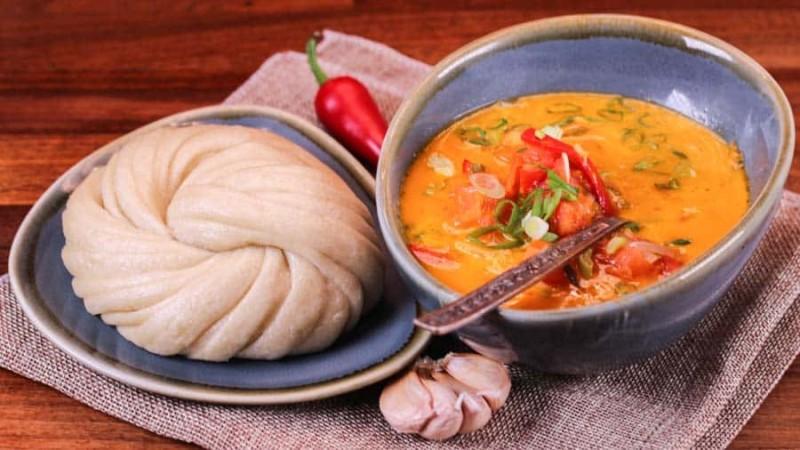
Ema Datshi - © ChainBaker
Festivals & Local Celebrations
Punakha is home to some of Bhutan’s most vibrant and culturally significant festivals. These festivals not only provide spiritual significance but also showcase Punakha’s vibrant community spirit. Travelers attending these events will experience the warmth of Bhutanese hospitality, with locals often inviting visitors to join in the celebrations.
Punakha Tshechu
The Punakha Tshechu is an annual festival held in the magnificent Punakha Dzong. It is one of Bhutan’s most important religious events, celebrating Guru Rinpoche, who brought Buddhism to Bhutan. The festival features elaborate mask dances performed by monks, each dance representing different aspects of Bhutanese history and mythology. Visitors are welcome to watch the festivities, which are believed to bring blessings and protect against evil spirits.
Punakha Drubchen
The Punakha Drubchen is another major festival that commemorates Bhutan’s victory over Tibetan invaders in the 17th century. The festival is a reenactment of the battle, where locals dress in traditional military attire and perform ancient warrior dances. It’s a unique opportunity to see Bhutan’s martial history brought to life through dance and drama.
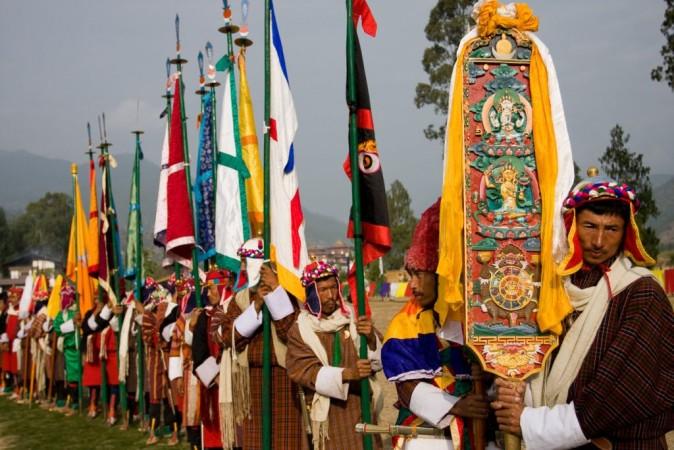
Punakha Drubchen - © Bhutan Tourism
What to Do in Punakha
- Hiking Routes in Punakha: Punakha is surrounded by stunning landscapes, making it a hiker’s paradise. Popular hikes include the trail to Khamsum Yulley Namgyal Chorten, which takes you through rice terraces and lush forests, offering breathtaking views of the valley. Trekking routes range from easy walks to more challenging multi-day journeys, perfect for nature lovers and adventure enthusiasts.
- River Rafting: For thrill-seekers, Punakha offers river rafting on the Pho Chhu and Mo Chhu rivers. These rivers provide both gentle floats and more intense rapids, making it a fun activity for beginners and experienced rafters alike. The rafting experience also offers stunning views of the Punakha Dzong and surrounding landscapes.
- Bird Watching: Punakha is home to diverse bird species, making it a popular destination for bird watchers. The region’s wetlands and forests are habitats for rare species like the white-bellied heron and the black-necked crane. Guided bird-watching tours are available, offering a peaceful way to explore Punakha’s natural beauty.
- Meditation & Spiritual Retreats: For those seeking peace and tranquility, Punakha is the perfect destination for meditation and spiritual retreats. Many monasteries and temples offer quiet spaces for reflection and guided meditation sessions. Visitors can also join spiritual retreats to learn about Bhutanese Buddhism and connect with the local culture on a deeper level.
Shopping in Punakha
- Handicrafts Stores: Punakha is known for its beautiful hand-woven textiles and intricate wooden carvings. You’ll find a variety of handmade goods, including scarves, blankets, and intricate religious items like prayer wheels and small statues. These items make for meaningful souvenirs and support local artisans.
- Punakha Markets: Exploring Punakha’s local markets is a great way to immerse yourself in the local culture. The markets offer a range of goods, from fresh produce to handmade crafts. Visitors can also find yak wool products, which are popular for their warmth and durability, especially in the colder months.
- Yak Wool Products Stores: Bhutan is famous for its hand-woven textiles, and Punakha is no exception. Visitors can purchase beautiful pieces made from natural fibers, including yak wool. These textiles are often woven in traditional patterns, making them not only functional but also a piece of Bhutanese art.
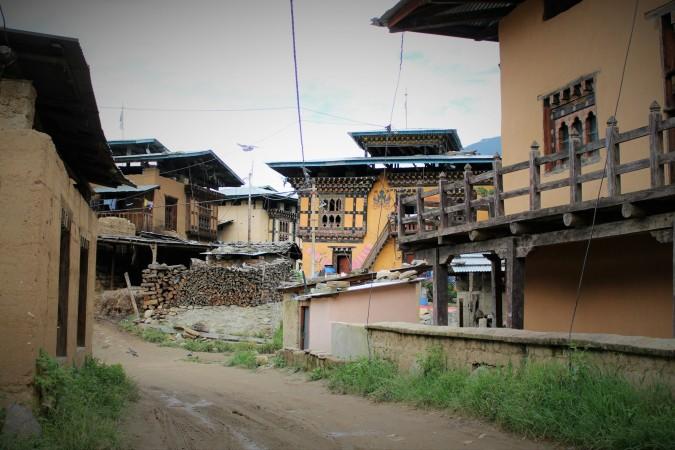
Explore Punakha village - © Deepavali Gaind
Weather in Punakha: Best Time to Visit
Punakha enjoys a subtropical climate, making it one of the warmer regions in Bhutan. The town's weather is generally mild throughout the year, but each season offers its own unique experience for travelers. Understanding the weather conditions will help you plan your visit for the activities and experiences you want.
Spring in Punakha
Spring is one of the best times to visit Punakha, with pleasant temperatures ranging from 15°C to 25°C (59°F to 77°F). The valley comes alive with blooming flowers, and the rice fields start to turn green. This is also a popular time for trekking and sightseeing, as the skies are clear, offering stunning views of the surrounding mountains.
Summer in Punakha
Summers in Punakha are warm, with temperatures reaching up to 30°C (86°F). The region experiences monsoon rains during this time, with heavy downpours in the afternoons. Although the rain can limit outdoor activities, the valley becomes lush and vibrant, and it’s a great time to experience the region’s agricultural life.
Autumn in Punakha
Autumn is another peak season for tourists in Punakha. With temperatures ranging between 10°C and 23°C (50°F to 73°F), the weather is cool and dry. The rice terraces turn golden, and the harvest season brings a festive atmosphere. This is the ideal time for outdoor activities like hiking, river rafting, and bird watching.
Winter in Punakha
Winters in Punakha are mild compared to other parts of Bhutan. Temperatures can drop to around 5°C (41°F) at night but remain comfortable during the day, averaging between 10°C and 15°C (50°F to 59°F). It’s a peaceful time to visit, with fewer tourists and crisp, clear skies perfect for photography and sightseeing.
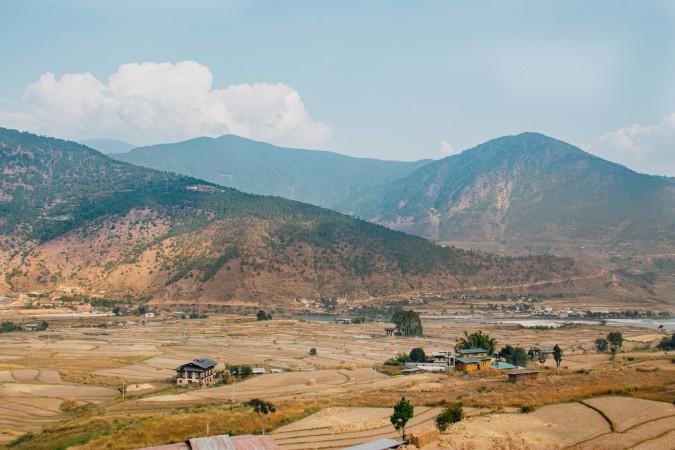
The beauty of Punakha Valley - © Aaron Santelices
Essential Travel Information
Getting Around Punakha
- Bicycles: For a more eco-friendly and active way to explore Punakha, biking will give the freedom to stop and explore at your own pace. You can ride through the valley’s picturesque rice terraces, riverside paths, and traditional villages. The terrain in Punakha is mostly flat, making cycling an enjoyable and leisurely activity for all fitness levels.
- Walking: Punakha’s compact size makes it easy to explore certain areas on foot. Walking is a fantastic way to take in the tranquil atmosphere and discover hidden spots that might be missed when traveling by car. You can walk along the Punakha Suspension Bridge, wander through rice fields, or take leisurely strolls through the town and local markets.
- Horseback Riding: For a unique transportation experience, horseback riding is available in some parts of Punakha. Although it’s not a common method of transportation, it is a fun and scenic way to explore the more rural and mountainous areas of Punakha.
- Rafts and Boats: While not a traditional method of transportation, rafting along the Mo Chhu and Pho Chhu rivers is a popular activity that also offers a unique way to see Punakha’s landscape. Although rafting is mostly for recreation, it’s an adventurous way to experience the region.
ATM & Banking Services
When visiting Punakha, it's important to be prepared with cash, as banking services and ATMs are limited. Although you can find a few ATMs around the town center, not all of them accept international cards, so it’s advisable to withdraw sufficient funds in larger cities like Thimphu or Paro before traveling to Punakha. Credit card usage is also limited, primarily accepted at upscale hotels and restaurants. For daily expenses, including shopping at local markets and paying for transportation, it’s best to carry cash in Bhutanese Ngultrum (BTN) or Indian rupees, both of which are widely accepted in Punakha.
Where to Stay in Punakha
- Luxury Resorts: For travelers looking to indulge, Punakha has several luxury resorts that provide stunning views of the surrounding valley and mountains. These eco-friendly resorts combine modern amenities with traditional Bhutanese architecture, offering a peaceful retreat with spa services, fine dining, and beautifully landscaped gardens.
- Mid-Range Hotels: These hotels are ideal for travelers looking for convenience and affordability without sacrificing comfort. Many are located near major attractions like the Punakha Dzong and offer amenities such as on-site dining, free Wi-Fi, and traditional Bhutanese decor, making them a great option for those seeking a balance of price and quality.
- Guesthouses & Homestays: For those looking for a more personal and budget-friendly experience, Punakha has a variety of guesthouses and homestays. Staying with a local family in a homestay offers a unique opportunity to experience Bhutanese culture firsthand, with home-cooked meals and the chance to participate in daily life. Guesthouses, on the other hand, provide simple but comfortable accommodations, often run by locals who are happy to share their knowledge of the area and offer a more intimate, community-focused stay.
Articles for you

Explore Yala National Park - Sri Lanka Travel, Asia
Tucked away in Sri Lanka’s southeastern corner, Yala National Park is where wild nature meets deep tradition. Known worldwide for its leopard population, the park is also home to elephants, sloth bears, crocodiles, and hundreds of bird species. Beyond wildlife, Yala opens doors to a cultural landscape dotted with ancient temples, Buddhist ruins, and coastal villages. For travelers seeking more than just a safari, Yala offers a chance to explore eco-tourism, local communities, and sacred heritage sites.
Population: The Yala National Park area doesn’t have a human population.
Economy: The economy around Yala National Park thrives on a blend of eco-tourism, agriculture, and local services. Safari tours, eco-lodges, and cultural experiences drive steady income for nearby towns like Tissamaharama and Kataragama, supporting thousands of families.
Landmarks: Famous for Block I of Yala and wildlife encounters, including elephants, sloth bears, crocodiles, and exotic bird species.

Explore Galle - Sri Lanka Travel, Asia
Nestled on Sri Lanka’s southern coastline, Galle is a vibrant city where history meets the sea. Its cobbled streets, colonial architecture, and serene beaches make it a must-visit destination for travelers seeking a blend of culture, adventure, and relaxation. A UNESCO World Heritage site, Galle captivates visitors with its Dutch Fort, bustling markets, and friendly locals. Whether you’re exploring the ramparts at sunset or savoring fresh seafood by the shore, Galle promises an unforgettable journey into Sri Lanka’s heritage.
Population: Approximately 113,000 in 2023.
Economy: Galle’s economy thrives on tourism, trade, and fisheries. The city’s historic fort, colonial architecture, and coastal charm draw thousands of international visitors each year, making tourism its main economic driver. Fishing remains vital for local livelihoods, supplying fresh seafood across the region.
Landmarks: Famous for the Galle Fort, Dutch Reformed Church & Maritime Museum, and Unawatuna Beach.

Explore Bentota - Sri Lanka Travel, Asia
Nestled along Sri Lanka’s southwestern coast, Bentota is a tropical paradise that blends golden beaches, vibrant culture, and thrilling adventures. Famous for its calm waters, luxury resorts, and scenic river estuary, Bentota has become a top destination for travelers seeking both relaxation and authentic experiences. From serene beach walks at sunrise to adrenaline-pumping water sports, this coastal town offers a perfect balance of leisure and exploration. With its proximity to Colombo and Galle, Bentota is easy to reach, making it an ideal stop for both short escapes and extended holidays.
Population: Approximately 37,000 in 2023.
Economy: Bentota’s economy thrives mainly on tourism, which drives local businesses such as hotels, restaurants, and wellness retreats. The town also benefits from fishing, coconut cultivation, and handicrafts like wood carving and batik textiles. Many residents rely on the growing demand for water sports and Ayurvedic treatments, making tourism the backbone of both income and employment in the area.
Landmarks: Famous for Bentota Beach, Bentota River Safari, and Kande Vihara Temple.

Explore Mirissa - Sri Lanka Travel, Asia
Mirissa is a charming coastal town on Sri Lanka’s southern shoreline. Known for its golden beaches, turquoise waters, and vibrant marine life, it has become a must-visit stop for travelers exploring the island. Many come for whale watching, surfing, and sunset views at Coconut Tree Hill, but Mirissa offers much more than postcard beauty. The fishing boats you see anchored by the bay carry generations of stories. Local traditions, delicious cuisine, and a laid-back rhythm of life shape every visitor’s experience.
Population: Approximately 4,700 in 2023.
Economy: Mirissa’s economy is largely shaped by its coastal location. Fishing has long been the backbone of local livelihoods, with generations relying on the Indian Ocean for income. In recent decades, tourism has become the main driver of growth, thanks to whale watching, surfing, and beachside hospitality.
Landmarks: Famous for Mirissa Beach, Coconut Tree Hill, and Parrot Rock Bridge.

Explore Nuwara Eliya - Sri Lanka Travel, Asia
Tucked away in the Central Highlands of Sri Lanka, Nuwara Eliya is often called “Little England”. With its rolling tea plantations, cool misty mornings, and colonial charm, this mountain town feels like a step into another world. Travelers come here to breathe fresh air, walk through flower gardens, sip the finest Ceylon Tea, and enjoy a pace of life far from the island’s busy cities. Whether you’re drawn by scenic landscapes, heritage architecture, or the warmth of its people, Nuwara Eliya is a destination that blends nature, culture, and history in perfect harmony.
Population: Approximately 781,000 in 2023.
Economy: Nuwara Eliya’s economy thrives mainly on tea production, as it sits in the heart of Sri Lanka’s central highlands, famous worldwide for Ceylon Tea. The city also benefits from a growing tourism industry, attracting visitors with its colonial charm, cool climate, and scenic landscapes.
Landmarks: Famous for Gregory Lake, Hakgala Botanical Garden, and Victoria Park.

Explore Sukau - Malaysia Travel, Asia
Nestled on the banks of the Kinabatangan River in Sabah, Malaysian Borneo, Sukau is a destination where wildlife, culture, and conservation come together. Known as one of Asia’s top spots for river safaris and eco-tourism, this quiet village offers a front-row seat to encounters with Bornean orangutans, pygmy elephants, proboscis monkeys, and exotic birdlife.
Population: Approximately 1,400 in 2019.
Economy: Sukau’s economy is shaped by its riverine location and natural resources. Traditionally, the Orang Sungai community relied on fishing, small-scale farming, and forest gathering for their livelihood. Today, the village has shifted toward eco-tourism, with river cruises, jungle trekking, and homestays providing income.
Landmarks: Famous for the Kinabatangan River cruises, Gomantong Caves, and Ox-bow lakes and wetlands.
